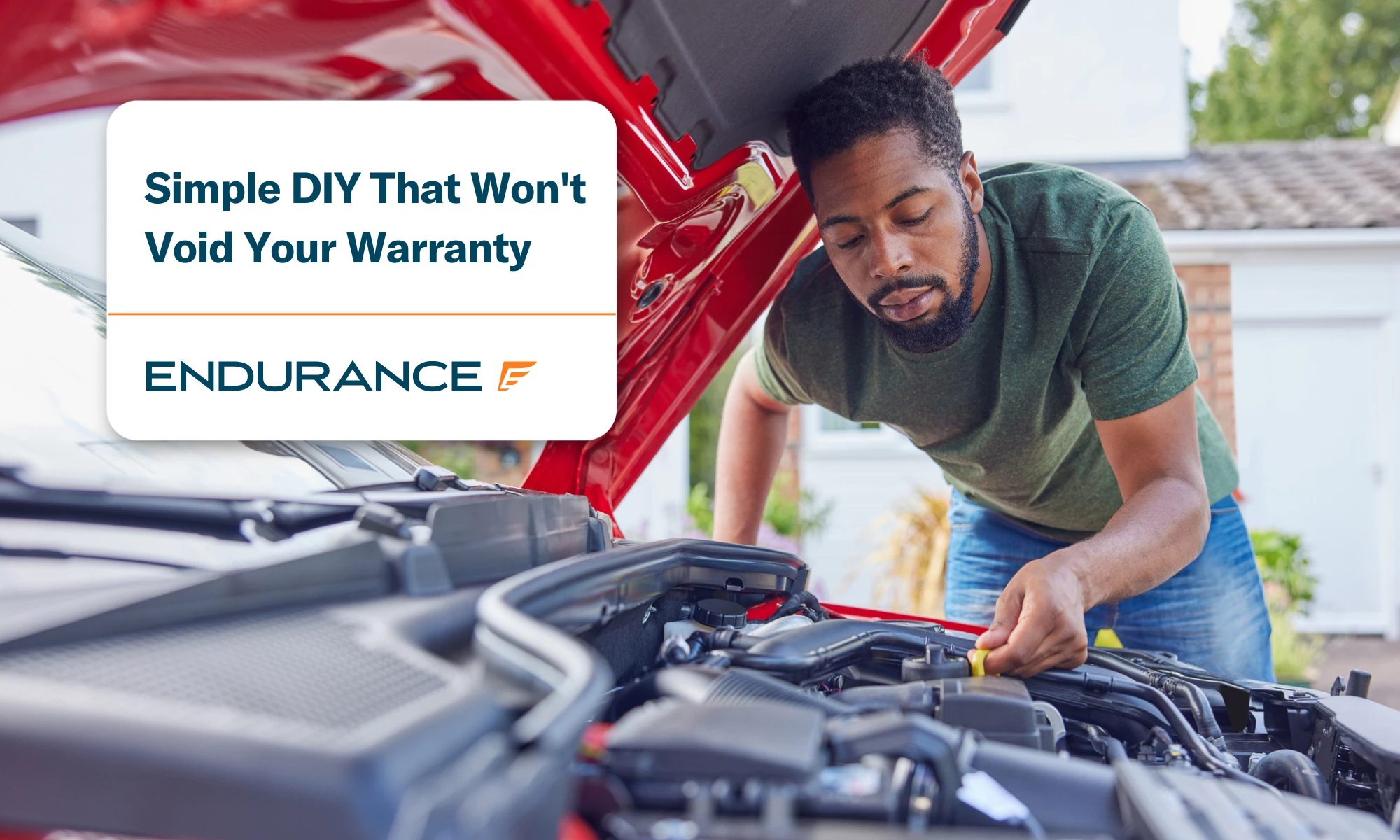¡Consigue esta oferta! Llama ahora.
Hable con un especialista en planes de protección de vehículos y obtenga $300 apagado cualquier nuevo contrato al instante.
Llamar 866-678-4172
o escanea el código a continuación


Routine maintenance tasks, such as replacing fuel filters y bujías, enhance long-term reliability by ensuring clean fuel delivery and efficient combustion. Clean fuel filters prevent contaminants from reaching your engine, while properly gapped spark plugs keep combustion efficient and consistent, both helping your engine run smoothly and avoid unexpected breakdowns.
Best of all, neither of these maintenance tasks will anulará su garantía extendida de automóvil should you decide to carry them out yourself. Find out more in this comprehensive guide.
Fuel filters act as guardians between the fuel pump and engine, trapping debris and contaminants before they reach vital engine components. When the filter begins to clog, the pump works harder, fuel pressure may drop, and the engine can stumble under load. If left unchecked, restricted flow can create lean conditions, hesitation, and premature pump wear.
Fuel filter replacement at sensible intervals restores proper flow so the engine burns a clean mixture, which protects power, emissions equipment, and fuel economy. Most owners can handle this do-it-yourself (DIY) job with patience, gloves, and basic hand tools.
Always park safely, relieve fuel pressure according to your manual, and keep rags ready to capture any drips. Note that some modern vehicles integrate the filter with the in-tank module. If this is the case for yours, the work is best left to a professional shop.
The average DIY fuel filter job costs between $15 and $40 in parts, while a shop may charge $100–$200 in labor. Replacement intervals range from every 20,000 miles on older vehicles to more than 100,000 miles on newer ones. Skipping this service can cause a fuel pump replacement (often $1,000 or more), so this small task is an investment in avoiding a big repair later.
For a brief overview of how to replace your fuel filter by yourself:
Spark plugs ignite the compressed mixture in each cylinder. When tips wear or foul, voltage requirements climb, misfires appear, and catalytic converters can overheat. Fresh plugs restore crisp starts, smooth idle, and consistent acceleration.
Follow the service interval listed in your owner’s manual, but modern iridium or platinum designs last longer than older copper styles. The typical spark plug replacement cost depends on plug type, cylinder count, and access. Doing the work yourself with the proper socket and a torque wrench can lower the bill dramatically.
Signs you may need spark plug replacement include:
If any of these symptoms appear, consider replacement sooner rather than later.
Iridium plugs can often last 100,000 miles, but checking them periodically is wise, especially if you drive short trips or tow heavy loads. Poor plugs increase strain on ignition coils, which can cost hundreds to replace. Fresh plugs also improve emissions, helping you pass inspection and maintain manufacturer compliance. All of this ties directly into warranty preservation, since emission system failures can be extremely expensive.
For a brief overview of how to replace your spark plugs by yourself:
A small set of tools and some good info can go a long way. Download or purchase a reputable service manual, keep a maintenance log, and prep parts and tools before you start. Protect painted surfaces with fender covers, set a clean parts tray nearby, and photograph any hose routing for reference. If you run into resistance, pause and reassess rather than forcing a component. Use new crush washers and O-rings when the procedure calls for them, and always keep a fire extinguisher (rated for automotive use) within reach.
Low-risk tasks most owners can handle include:
Where appropriate, power steering fluid refreshes are also manageable, provided you follow the reservoir procedure and dispose of fluids responsibly. These wins reduce costs, build confidence, and help you better understand the condition of your vehicle.
When writing up your log, remember to include dates, mileage, part numbers, and torque specs. It’s a good habit that supports any car warranty discussion and shows you maintain the vehicle on schedule. If you have any sort of extended warranty or vehicle service contract (VSC), detailed records can speed up a claim and avoid any confusion.
Routine wear items like a fuel filter, air filter, or spark plugs are considered maintenance. They’re rarely covered as parts under a service contract, but properly maintaining them helps prevent breakdowns later. A vehicle service contract generally steps in when a covered component fails from a mechanical or electrical breakdown, not when a scheduled item simply wears out.
Doing your own simple maintenance will not void warranty. Problems only arise when work is performed incorrectly and directly causes damage. For example, cross-threading a plug or failing to tighten a fuel line fitting could create another issue. Use correct procedures, verify your work, and save receipts so you can demonstrate due care if questions ever arise.
If in doubt, use these warranty-friendly dos and don’ts to help guide you:
A smart maintenance strategy balances DIY with periodic professional inspection. You save money and learn more about your car by handling fuel filters, spark plugs, and air filters at home, but scheduled visits with certified mechanics catch deeper issues that an untrained eye may miss. Professionals have scanners to interpret trouble codes, pressure testers to measure fuel system health, and can rectify your vehicle after safety recalls.
Annual brake inspections, suspension checks, transmission service, advanced diagnostics for warning lights, alignment, and electronic calibration are tasks best left to shops. Attempting them without equipment puts your safety at risk and could raise warranty disputes. By contrast, showing service receipts alongside your DIY log shows good car ownership and strengthens any extended warranty claim.
Replacing a fuel filter and swapping spark plugs are small projects with big payoffs. Both improve drivability, guard engine longevity, and cost far less than major repairs. Handled carefully, each task fits squarely into the category of simple DIY tasks that won’t jeopardize your car warranty as long as they’re carried out carefully. Gather your tools, review the steps, and take your time. If anything seems unclear, stop and consult a trusted shop. Either way, your preparation and documentation will keep your vehicle reliable and your paperwork in order.
No matter how much you care for your vehicle, component failure is unfortunately inevitable—and you want to make sure you’re protected when it happens. While there are plenty of extended auto warranty or aftermarket VSC providers to choose from, Endurance Warranty Services offers a wide range of plans designed to cater to all types of drivers, but we also include a fantastic set of benefits as standard (such as 24/7 roadside assistance, trip interruption costs, and rental car reimbursement).
To find out which of our plans might be right for you, chat with an Endurance advisor at (800) 253-8203 o solicitar una Cotización Gratis. También puedes comprar en línea para ver tu precio and plan recommendations immediately.
Explora nuestro Blog de garantía extendida for additional helpful articles on DIY maintenance, money-saving tips, and more.

Hemos recibido la información de su vehículo y nos comunicaremos con usted en breve con su cotización.
- O -
Comience a buscar un plan de cobertura ahora.

Estamos aquí para asegurarnos de que obtenga la protección EV más completa. Por eso nos hemos asociado con Xcelerate automático para ofrecerle una cobertura Tesla transparente y confiable.
¿Quiere que nos comuniquemos con usted acerca de la cobertura XCare para su Tesla?



Su protección es nuestra principal prioridad. Su cotización está en proceso y usted
recibirá un correo electrónico de confirmación en breve.


Hable con un especialista en planes de protección de vehículos y obtenga $300 de descuento en cualquier contrato nuevo al instante.

¡Llama y obtén un descuento de $300 en cualquier plan nuevo!
Al hacer clic en el botón, acepta que Endurance utilice tecnología automatizada para llamarlo, enviarle un correo electrónico y enviarle mensajes de texto utilizando la información de contacto anterior, incluido su número de teléfono móvil, si se proporciona, con respecto a la protección del automóvil o, en California, el seguro contra averías mecánicas. También acepta el Endurance política de privacidad y Términos y condiciones. El consentimiento no es una condición de compra y puede retirar el consentimiento en cualquier momento. Se pueden aplicar tarifas por mensajes y datos.


Hable con un especialista en planes de protección de vehículos y obtenga $300 apagado cualquier nuevo contrato al instante.
Llamar 866-678-4172
o escanea el código a continuación



Simplemente complete la información a continuación y le daremos seguimiento rápidamente con su cotización gratuita y sin compromiso.
Al hacer clic en el botón, acepta que Endurance utilice tecnología automatizada para llamarlo, enviarle un correo electrónico y enviarle mensajes de texto utilizando la información de contacto anterior, incluido su número de teléfono móvil, si se proporciona, con respecto a la protección del automóvil o, en California, el seguro contra averías mecánicas. También acepta el Endurance política de privacidad y Términos y condiciones. El consentimiento no es una condición de compra y puede retirar el consentimiento en cualquier momento. Se pueden aplicar tarifas por mensajes y datos.

Para hablar con un especialista en planes de protección de vehículos y guardar $300
Escanee el código a continuación
Justin Barrett, propietario de Barrett Automotriz Talleres en Eastanollee y Cornelia, Georgia, con casi 20 años de experiencia en reparación y diagnóstico de vehículos. Desde que fundó su taller de reparación de automóviles con su esposa en 2010, se ha dedicado a ayudar a los conductores con todo, desde el mantenimiento rutinario hasta las reparaciones más complejas. Leer más Acerca de Justin.